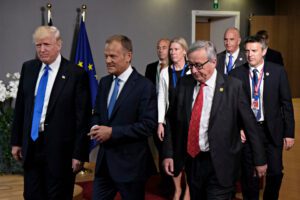The European Union and the United States are close to finalising a trade agreement that would impose 15 per cent tariffs on most EU exports, in a move designed to avert a broader trade war but still likely to sting key European industries.
Diplomatic sources confirmed that member states were briefed on Wednesday by the European Commission about the proposed deal, which would mirror terms recently agreed between the US and Japan. The deal would apply to most goods, though exemptions are being considered for aircraft and medical devices.
In a bid to soften the terms, the EU has offered to cut its average most-favoured-nation tariff rate of 4.8 per cent to zero on selected products as part of an agreement in principle. However, if the deal proceeds, it would still leave the bloc worse off than the UK, which has secured a 10 per cent baseline tariff agreement with the US.
For the German car industry, the proposed 15 per cent tariff would represent a significant blow. While lower than the current 27.5 per cent rate, it is still more than five times the 2.75 per cent duty in place before Donald Trump returned to the White House earlier this year.
The agreement is now in the hands of President Trump, who has made reshaping trade relationships a cornerstone of his second term. However, the White House has yet to confirm the deal, with spokesperson Kush Desai cautioning that “any discussion of trade deals is speculation unless announced by the president.”
While negotiations continue, Brussels is preparing a sweeping package of countermeasures should Trump reject the deal. On Wednesday, the European Commission threatened to impose €93 billion (£80 billion) in retaliatory tariffs on a wide range of US goods.
This would include products from an earlier €21 billion list—featuring poultry and spirits—merged with a newer €72 billion list that targets high-value items such as cars and Boeing aircraft.
If approved by EU member states in a vote expected in the coming days, the counter-tariffs would come into effect as early as 7 August. EU diplomats have also discussed invoking the Anti-Coercion Instrument (ACI), a powerful legal tool that could go beyond tariffs and allow the bloc to ban certain US services—a move that would significantly affect US tech firms operating in Europe.
Only France has called for immediate implementation of the ACI, arguing that the bloc must demonstrate it is willing to act decisively.
“The EU’s primary focus is on achieving a negotiated outcome with the US,” said Olof Gill, trade spokesperson for the European Commission. “But we are also preparing for all outcomes. To make countermeasures clearer, simpler and stronger, we will merge lists 1 and 2 into a single list.”
Some analysts argue the EU has already mishandled its negotiating position. Tobias Gehrke, senior policy fellow at the European Council on Foreign Relations, said the bloc had failed to use its leverage after Trump issued his 30 per cent tariff threat earlier this month.
“There is a sense that the bloc has fumbled its hand, despite holding decent cards,” Gehrke said. “The EU should have immediately retaliated against US tariffs. While the mantra ‘negotiate from a position of strength’ was oft-repeated in speeches, any associated actions never materialised.”
A final agreement on tariffs is expected to be a key point of discussion in Thursday’s summit with China, which will bring together European Commission president Ursula von der Leyen, EU Council president António Costa, and Chinese president Xi Jinping.
With pressure mounting on both sides of the Atlantic, the coming days will prove crucial in determining whether the EU and US can agree to a compromise—or escalate into a full-scale trade confrontation.
Read more:
EU and US close in on trade deal with 15% tariffs as Brussels prepares retaliatory strike
